How Do Climate Change and Deglaciation Affect Runoff Formation Mechanisms in the High-Mountain River Basin of the North Caucasus?
Abstract
1. Introduction
2. Study Area
3. Materials and Methods
3.1. ECOMAG Runoff Formation Model
3.2. Numerical Experiments to Assess the Sensitivity of Water Regime Characteristics to Changes in Input Conditions
- Reduction in the modern glacier area (scenario led): 75%, 50%, and 25% of the current glaciation area (scenarios ice75, ice50, and ice25), and the absence of glaciers (scenario ice0);
- Change in actual daily precipitation (scenario pre): pre+5%, pre+10%, and pre+20% is an increase in precipitation of 5, 10, and 20%, and pre-5%, pre-10%, and pre-20% is a decrease in precipitation of 5, 10, and 20%, respectively;
- Changes in the actual air temperature (scenario temp): temp+2, temp+4, and temp+6 is an increase in air temperature by 2, 4, and 6 °C, respectively.
3.3. Scenario Modeling of Runoff Considering Climatic and Glacial Changes
3.4. CORDEX Project
3.5. GloGEMflow-DD Model
4. Results
4.1. Calibration and Validation of the Runoff Formation Model
4.2. Numerical Experiments to Assess the Sensitivity of Water Regime Characteristics to Changes in Input Conditions
4.2.1. Sensitivity of Water Regime Characteristics to Changes in Glaciation
4.2.2. Sensitivity of Water Regime Characteristics to Changes in Precipitation
4.2.3. Sensitivity of Water Regime Characteristics to Changes in Air Temperature
4.3. Modeling Results on the Transformation of Flow Formation Mechanisms
4.3.1. Air Temperature
4.3.2. Glaciation
4.3.3. Precipitation
4.3.4. Snowline
4.3.5. Annual Runoff
4.3.6. Flow Regime
5. Discussion
6. Conclusions
Author Contributions
Funding
Institutional Review Board Statement
Informed Consent Statement
Data Availability Statement
Conflicts of Interest
References
- Jones, J.A. Hydrologic responses to climate change: Considering geographic context and alternative hypotheses. Hydrol. Process. 2011, 25, 5. [Google Scholar] [CrossRef]
- Adler, C.; Huggel, C.; Orlove, B.; Nolin, A. Climate change in the mountain cryosphere: Impacts and responses. Reg. Environ. Change 2019, 19, 1225–1228. [Google Scholar] [CrossRef]
- Milner, A.M.; Khamis, K.; Battin, T.J.; Brittain, J.E.; Barrand, N.E.; Füreder, L.; Cauvy-Fraunié, S.; Gíslason, G.M.; Jacobsen, D.; Hannah, D.M.; et al. Glacier shrinkage driving global changes in downstream systems. Proc. Natl. Acad. Sci. USA 2017, 114, 9770–9778. [Google Scholar] [CrossRef]
- Bliss, A.; Hock, R.; Radić, V. Global response of glacier runoff to twenty-first century climate change. J. Geophys. Res. Earth Surf. 2014, 119, 717–730. [Google Scholar] [CrossRef]
- Pellicciotti, F.; Bauder, A.; Parola, M. Effect of glaciers on streamflow trends in the Swiss Alps. Water Resour. Res. 2010, 46. [Google Scholar] [CrossRef]
- Carrivick, J.L.; Tweed, F.S. A global assessment of the societal impacts of glacier outburst floods. Glob. Planet. Change 2016, 144, 1–16. [Google Scholar] [CrossRef]
- Harrison, S.; Kargel, J.S.; Huggel, C.; Reynolds, J.; Shugar, D.H.; Betts, R.A.; Emmer, A.; Glasser, N.; Haritashya, U.K.; Klimeš, J.; et al. Climate change and the global pattern of moraine-dammed glacial lake outburst floods. Cryosph 2018, 12, 1195–1209. [Google Scholar] [CrossRef]
- Tielidze, L.G.; Bolch, T.; Wheate, R.D.; Kutuzov, S.S.; Lavrentiev, I.I.; Zemp, M. Supra-glacial debris cover changes in the Greater Caucasus from 1986 to 2014. Cryosphere 2020, 14, 585–598. [Google Scholar] [CrossRef]
- Hugonnet, R.; McNabb, R.; Berthier, E.; Menounos, B.; Nuth, C.; Girod, L.; Farinotti, D.; Huss, M.; Dussaillant, I.; Brun, F.; et al. Accelerated global glacier mass loss in the early twenty-first century. Nature 2021, 592, 726–731. [Google Scholar] [CrossRef] [PubMed]
- Tielidze, L.G.; Wheate, R.D. The Greater Caucasus Glacier Inventory (Russia, Georgia and Azerbaijan). Cryosphere 2018, 12, 81–94. [Google Scholar] [CrossRef]
- Marzeion, B.; Hock, R.; Anderson, B.; Bliss, A.; Champollion, N.; Fujita, K.; Huss, M.; Immerzeel, W.W.; Kraaijenbrink, P.; Malles, J.H.; et al. Partitioning the Uncertainty of Ensemble Projections of Global Glacier Mass Change. Earth’s Futur. 2020, 8, e2019EF001470. [Google Scholar] [CrossRef]
- Shahgedanova, M.; Hagg, W.; Zacios, M.; Popovnin, V. An Assessment of the Recent Past and Future Climate Change, Glacier Retreat, and Runoff in the Caucasus Region Using Dynamical and Statistical Downscaling and HBV-ETH Hydrological Model. In Regional Aspects of Climate-Terrestrial-Hydrologic Interactions in Non-boreal Eastern Europe; Springer: Dordrecht, The Netherlands, 2009; pp. 63–72. [Google Scholar]
- Tashilova, A.; Ashabokov, B.; Kesheva, L.; Teunova, N. Analysis of Climate Change in the Caucasus Region: End of the 20th–Beginning of the 21st Century. Climate 2019, 7, 11. [Google Scholar] [CrossRef]
- Zolotarev, E.; Kharkovets, E. Development of glaciers of mount Elbrus after the Little Ice Age. Ice Snow 2015, 52, 15. [Google Scholar] [CrossRef]
- Kutuzov, S.; Legrand, M.; Preunkert, S.; Ginot, P.; Mikhalenko, V.; Shukurov, K.; Poliukhov, A.; Toropov, P. The Elbrus (Caucasus, Russia) ice core record-Part 2: History of desert dust deposition. Atmos. Chem. Phys. 2019, 19, 14133–14148. [Google Scholar] [CrossRef]
- Toropov, P.A.; Aleshina, M.A.; Grachev, A.M. Large-scale climatic factors driving glacier recession in the Greater Caucasus, 20th–21st century. Int. J. Climatol. 2019, 39, 4703–4720. [Google Scholar] [CrossRef]
- Rets, E.P.; Durmanov, I.N.; Kireeva, M.B.; Smirnov, A.M.; Popovnin, V.V. Past ‘peak water’ in the North Caucasus: Deglaciation drives a reduction in glacial runoff impacting summer river runoff and peak discharges. Clim. Change 2020, 163, 2135–2151. [Google Scholar] [CrossRef]
- Rets, E.; Kireeva, M. Hazardous hydrological processes in mountainous areas under the impact of recent climate change: Case study of Terek River basin. IAHS-AISH Publ. 2010, 340, 126–134. [Google Scholar]
- Rahman, K.; Maringanti, C.; Beniston, M.; Widmer, F.; Abbaspour, K.; Lehmann, A. Streamflow Modeling in a Highly Managed Mountainous Glacier Watershed Using SWAT: The Upper Rhone River Watershed Case in Switzerland. Water Resour. Manag. 2013, 27, 323–339. [Google Scholar] [CrossRef]
- Omani, N.; Srinivasan, R.; Karthikeyan, R.; Smith, P. Hydrological Modeling of Highly Glacierized Basins (Andes, Alps, and Central Asia). Water 2017, 9, 111. [Google Scholar] [CrossRef]
- Singh, V.; Jain, S.K.; Shukla, S. Glacier change and glacier runoff variation in the Himalayan Baspa river basin. J. Hydrol. 2021, 593, 125918. [Google Scholar] [CrossRef]
- Duethmann, D.; Bolch, T.; Farinotti, D.; Kriegel, D.; Vorogushyn, S.; Merz, B.; Pieczonka, T.; Jiang, T.; Su, B.; Güntner, A. Attribution of streamflow trends in snow and glacier melt-dominated catchments of the Tarim River, Central Asia. Water Resour. Res. 2015, 51. [Google Scholar] [CrossRef]
- Huss, M.; Fischer, M. Sensitivity of very small glaciers in the swiss alps to future climate change. Front. Earth Sci. 2016, 4, 34. [Google Scholar] [CrossRef]
- Wiersma, P.; Aerts, J.; Zekollari, H.; Hrachowitz, M.; Drost, N.; Huss, M.; Sutanudjaja, E.H.; Hut, R. Coupling a global glacier model to a global hydrological model prevents underestimation of glacier runoff. Hydrol. Earth Syst. Sci. 2022, 26, 5971–5986. [Google Scholar] [CrossRef]
- Yin, Z.; Feng, Q.; Liu, S.; Zou, S.; Li, J.; Yang, L.; Deo, R.C. The spatial and temporal contribution of glacier runoffto watershed discharge in the Yarkant River Basin, Northwest China. Water 2017, 9, 159. [Google Scholar] [CrossRef]
- Burger, F.; Ayala, A.; Farias, D.; Shaw, T.E.; MacDonell, S.; Brock, B.; McPhee, J.; Pellicciotti, F. Interannual variability in glacier contribution to runoff from a high-elevation Andean catchment: Understanding the role of debris cover in glacier hydrology. Hydrol. Process. 2019, 33, 214–229. [Google Scholar] [CrossRef]
- Mohammadi, B.; Gao, H.; Feng, Z.; Pilesjö, P.; Cheraghalizadeh, M.; Duan, Z. Simulating glacier mass balance and its contribution to runoff in Northern Sweden. J. Hydrol. 2023, 620, 129404. [Google Scholar] [CrossRef]
- Chen, L.; Zhang, Z.; Liu, C.; Xiong, S.; Zhang, W.; Gao, H.; Yi, Y. Incorporating glacier processes into hydrological simulations in the headwaters of the Yangtze and yellow Rivers. Sci. Total Environ. 2024, 951, 175474. [Google Scholar] [CrossRef] [PubMed]
- Toum, E.; Villalba, R.; Masiokas, M.H. Snow and Glacier Contributions to the Mendoza River in the Semiarid Central Andes of Argentina. Hydrol. Process. 2025, 39, e70132. [Google Scholar] [CrossRef]
- Muelchi, R.; Rössler, O.; Schwanbeck, J.; Weingartner, R.; Martius, O. River runoff in Switzerland in a changing climate-runoff regime changes and their time of emergence. Hydrol. Earth Syst. Sci. 2021, 25, 3071–3086. [Google Scholar] [CrossRef]
- Hagg, W.; Shahgedanova, M.; Mayer, C.; Lambrecht, A.; Popovnin, V. A sensitivity study for water availability in the Northern Caucasus based on climate projections. Glob. Planet. Change 2010, 73, 161–171. [Google Scholar] [CrossRef]
- Rets, E.; Khomiakova, V.; Kornilova, E.; Ekaykin, A.; Kozachek, A.; Mikhalenko, V. How and when glacial runoff is important: Tracing dynamics of meltwater and rainfall contribution to river runoff from headwaters to lowland in the Caucasus Mountains. Sci. Total Environ. 2024, 927, 172201. [Google Scholar] [CrossRef] [PubMed]
- RGI Consortium. RGI Consortium Randolph Glacier Inventory—A Dataset of Global Glacier Outlines: Version 6.0: Technical Report, Global Land Ice Measurements from Space; RGI Consortium: Boulder, CO, USA, 2017. [Google Scholar]
- Santer, B.D.; Wigley, T.M.L.; Boyle, J.S.; Gaffen, D.J.; Hnilo, J.J.; Nychka, D.; Parker, D.E.; Taylor, K.E. Statistical significance of trends and trend differences in layer-average atmospheric temperature time series. J. Geophys. Res. Atmos. 2000, 105, 7337–7356. [Google Scholar] [CrossRef]
- Hamed, K.H.; Ramachandra Rao, A. A modified Mann-Kendall trend test for autocorrelated data. J. Hydrol. 1998, 204, 182–196. [Google Scholar] [CrossRef]
- Shahgedanova, M.; Nosenko, G.; Kutuzov, S.; Rototaeva, O.; Khromova, T. Deglaciation of the Caucasus Mountains, Russia/Georgia, in the 21st century observed with ASTER satellite imagery and aerial photography. Cryosphere 2014, 8, 2367–2379. [Google Scholar] [CrossRef]
- Zemp, M.; Frey, H.; Gärtner-Roer, I.; Nussbaumer, S.U.; Hoelzle, M.; Paul, F.; Haeberli, W.; Denzinger, F.; Ahlstrøm, A.P.; Anderson, B.; et al. Historically unprecedented global glacier decline in the early 21st century. J. Glaciol. 2015, 61, 745–762. [Google Scholar] [CrossRef]
- Popovnin, V.; Gubanov, A.; Lisak, V.; Toropov, P. Recent Mass Balance Anomalies on the Djankuat Glacier, Northern Caucasus. Atmosphere 2024, 15, 107. [Google Scholar] [CrossRef]
- Rototaeva, O.V.; Nosenko, G.A.; Kerimov, A.M.; Kutuzov, S.S.; Lavrentiev, I.I.; Kerimov, A.A.; Nikitin, S.A.; Tarasova, L.N. Changes in the mass balance of the Garabashi glacier (Mt. Elbrus) at the turn of the XX-XXI centuries. Ice Snow 2019, 59, 5–22. [Google Scholar] [CrossRef]
- Motovilov, Y.G.; Gottschalk, L.; Engeland, K.; Belokurov, A. ECOMAG—Regional Model of Hydrological Cycle; Application to the NOPEX Region; Institute Report Series no.105; Department of Geophysics, University of Oslo: Oslo, Norway, 1999; 88p. [Google Scholar]
- Motovilov, Y.G. Hydrological simulation of river basins at different spatial scales: 1. Generalization and averaging algorithms. Water Resour. 2016, 43, 429–437. [Google Scholar] [CrossRef]
- Hock, R. Temperature index melt modelling in mountain areas. J. Hydrol. 2003, 282, 104–115. [Google Scholar] [CrossRef]
- Kuchment, L.; Motovilov, Y.; Nazarov, N. Sensitivity of Hydrological Systems; Nauka: Moscow, Russia, 1990. [Google Scholar]
- Pfeffer, W.T.; Arendt, A.A.; Bliss, A.; Bolch, T.; Cogley, J.G.; Gardner, A.S.; Hagen, J.O.; Hock, R.; Kaser, G.; Kienholz, C.; et al. The randolph glacier inventory: A globally complete inventory of glaciers. J. Glaciol. 2014, 60, 537–552. [Google Scholar] [CrossRef]
- Korneva, I.; Rybak, O.; Rybak, E. Correction of the model climatic data for simulation of the Central Caucasus mountain glaciers. Environ. Control Syst. 2024, 1, 9–22. [Google Scholar]
- Postnikova, T.; Rybak, O.; Gubanov, A.; Zekollari, H.; Huss, M.; Shahgedanova, M. Debris cover effect on the evolution of Northern Caucasus glaciers in the 21st century. Front. Earth Sci. 2023, 11, 1256696. [Google Scholar] [CrossRef]
- Giorgi, F.; Coppola, E.; Jacob, D.; Teichmann, C.; Abba Omar, S.; Ashfaq, M.; Ban, N.; Bülow, K.; Bukovsky, M.; Buntemeyer, L.; et al. The CORDEX-CORE EXP-I Initiative: Description and Highlight Results from the Initial Analysis. Bull. Am. Meteorol. Soc. 2022, 103, E293–E310. [Google Scholar] [CrossRef]
- Smiatek, G.; Kunstmann, H. Simulating future runoff in a complex terrain alpine catchment with EURO-CORDEX data. J. Hydrometeorol. 2019, 20, 1925–1940. [Google Scholar] [CrossRef]
- Sperna Weiland, F.C.; Visser, R.D.; Greve, P.; Bisselink, B.; Brunner, L.; Weerts, A.H. Estimating Regionalized Hydrological Impacts of Climate Change Over Europe by Performance-Based Weighting of CORDEX Projections. Front. Water 2021, 3, 713537. [Google Scholar] [CrossRef]
- Gao, Y.; Zhou, M.; Yu, Z.; Ju, Q.; Jin, J.; Zhang, D. Climate change impacts on seasonal runoff in the source region of the Yellow River: Insights from CORDEX experiments with uncertainty analysis. J. Hydrol. 2024, 645, 132132. [Google Scholar] [CrossRef]
- Zekollari, H.; Huss, M.; Farinotti, D. Modelling the future evolution of glaciers in the European Alps under the EURO-CORDEX RCM ensemble. Cryosph. 2019, 13, 1125–1146. [Google Scholar] [CrossRef]
- Hutter, K.; Hughes, T.J. Theoretical Glaciology. J. Appl. Mech. 1983, 51, 948. [Google Scholar] [CrossRef]
- Huss, M.; Farinotti, D. Distributed ice thickness and volume of all glaciers around the globe. J. Geophys. Res. Earth Surf. 2012, 117. [Google Scholar] [CrossRef]
- Rounce, D.R.; Hock, R.; McNabb, R.W.; Millan, R.; Sommer, C.; Braun, M.H.; Malz, P.; Maussion, F.; Mouginot, J.; Seehaus, T.C.; et al. Distributed Global Debris Thickness Estimates Reveal Debris Significantly Impacts Glacier Mass Balance. Geophys. Res. Lett. 2021, 48, e2020GL091311. [Google Scholar] [CrossRef]
- Millan, R.; Mouginot, J.; Rabatel, A.; Morlighem, M. Ice velocity and thickness of the world’s glaciers. Nat. Geosci. 2022, 15, 124–129. [Google Scholar] [CrossRef]
- Rounce, D.R.; Hock, R.; Maussion, F.; Hugonnet, R.; Kochtitzky, W.; Huss, M.; Berthier, E.; Brinkerhoff, D.; Compagno, L.; Copland, L.; et al. Global glacier change in the 21st century: Every increase in temperature matters. Science 2023, 379, 78–83. [Google Scholar] [CrossRef]
- Postnikova, T.N.; Rybak, O.O.; Gubanov, A.S.; Zekollari, H.; Huss, M. Mathematical Modeling of Elbrus Glaciers in the 21st Century: Part 2. Projections of Glacier Dynamics and Lake Formation under Various SSP Scenarios. Izv. Atmos. Ocean. Phys. 2024, 60, S169–S184. [Google Scholar] [CrossRef]
- Limareva, N.S.; David, W.; Narvaez, C.; Sein, D.V. The climate change of the Caucasus as a result of the global warming. Mod. Sci. Innov. 2017, 2, 15–26. [Google Scholar]
- Huss, M.; Hock, R. Global-scale hydrological response to future glacier mass loss. Nat. Clim. Chang. 2018, 8, 135–140. [Google Scholar] [CrossRef]
- Farinotti, D.; Usselmann, S.; Huss, M.; Bauder, A.; Funk, M. Runoff evolution in the Swiss Alps: Projections for selected high-alpine catchments based on ENSEMBLES scenarios. Hydrol. Process. 2012, 26, 1909–1924. [Google Scholar] [CrossRef]
- Immerzeel, W.W.; Pellicciotti, F.; Bierkens, M.F.P. Rising river flows throughout the twenty-first century in two Himalayan glacierized watersheds. Nat. Geosci. 2013, 6, 742–745. [Google Scholar] [CrossRef]
- Luo, Y.; Wang, X.; Piao, S.; Sun, L.; Ciais, P.; Zhang, Y.; Ma, C.; Gan, R.; He, C. Contrasting streamflow regimes induced by melting glaciers across the Tien Shan—Pamir—North Karakoram. Sci. Rep. 2018, 8, 16470. [Google Scholar] [CrossRef]
- Sadyrov, S.; Tanaka, K.; Satylkanov, R.; Khujanazarov, T.; Touge, Y.; Fujita, K. Modelling runoff components and hydrological processes in glaciated catchments of the inner Tien-Shan, Kyrgyzstan. Front. Earth Sci. 2024, 11, 1306476. [Google Scholar] [CrossRef]
- Elagina, N.; Rets, E.; Korneva, I.; Toropov, P.; Lavrentiev, I. Simulation of mass balance and glacial runoff of Mount Elbrus from 1984 to 2022. Hydrol. Sci. J. 2025, 18, 189–200. [Google Scholar] [CrossRef]
- Shannon, S.; Smith, R.; Wiltshire, A.; Payne, T.; Huss, M.; Betts, R.; Caesar, J.; Koutroulis, A.; Jones, D.; Harrison, S. Global glacier volume projections under high-end climate change scenarios. Cryosphere 2019, 13, 325–350. [Google Scholar] [CrossRef]
- Sakai, A.; Fujita, K. Contrasting glacier responses to recent climate change in high-mountain Asia. Sci. Rep. 2017, 7, 1–8. [Google Scholar] [CrossRef]
- Addor, N.; Rössler, O.; Köplin, N.; Huss, M.; Weingartner, R.; Seibert, J. Robust changes and sources of uncertainty in the projected hydrological regimes of Swiss catchments. Water Resour. Res. 2014, 50, 7541–7562. [Google Scholar] [CrossRef]
- Finger, D.; Vis, M.; Huss, M.; Seibert, J. The value of multiple data set calibration versus model complexity for improving the performance of hydrological models in mountain catchments. Water Resour. Res. 2015, 51, 1939–1958. [Google Scholar] [CrossRef]
- Etter, S.; Addor, N.; Huss, M.; Finger, D. Climate change impacts on future snow, ice and rain runoff in a Swiss mountain catchment using multi-dataset calibration. J. Hydrol. Reg. Stud. 2017, 13, 222–239. [Google Scholar] [CrossRef]
- Beniston, M. Climatic change in mountain regions: A review of possible impacts. Clim. Change 2003, 59, 5–31. [Google Scholar] [CrossRef]
- Tasser, E.; Leitinger, G.; Tappeiner, U. Climate change versus land-use change—What affects the mountain landscapes more? Land Use Policy 2017, 60, 60–72. [Google Scholar] [CrossRef]
- Jiménez-Olivencia, Y.; Ibáñez-Jiménez, Á.; Porcel-Rodríguez, L.; Zimmerer, K. Land use change dynamics in Euro-mediterranean mountain regions: Driving forces and consequences for the landscape. Land Use Policy 2021, 109, 105721. [Google Scholar] [CrossRef]
- Raihan, F.; Ondrasek, G.; Islam, M.S.; Maina, J.M.; Beaumont, L.J. Combined impacts of climate and land use changes on long-term streamflow in the upper halda basin, Bangladesh. Sustainability 2021, 13, 12067. [Google Scholar] [CrossRef]
- Polong, F.; Deng, K.; Pham, Q.B.; Linh, N.T.T.; Abba, S.I.; Ahmed, A.N.; Anh, D.T.; Khedher, K.M.; El-Shafie, A. Separation and attribution of impacts of changes in land use and climate on hydrological processes. Theor. Appl. Climatol. 2023, 151, 1337–1353. [Google Scholar] [CrossRef]
- Sharma, A.; Khare, R.; Choudhary, M.K.; Prasad, V. Hydrologic Impact Evaluation of Land Use and Land Cover Change in Subbasins of Tapi River Using SWAT Model. In Hydrology and Hydrologic Modelling, Proceedings of the 26th International Conference on Hydraulics, Water Resources and Coastal Engineering (HYDRO 2021), Surat, India, 23–25 December 2021; Lecture Notes in Civil Engineering; Springer Nature: Singapore, 2023; Volume 312. [Google Scholar]
- Jin, Z.; Zhao, Q.; Qin, X.; Zhang, J.; Zhang, H.; Qin, J.; Qin, Y.; Li, H.; Chen, J.; Liu, Y.; et al. Quantifying the impact of landscape changes on hydrological variables in the alpine and cold region using hydrological model and remote sensing data. Hydrol. Process. 2021, 35, e14392. [Google Scholar] [CrossRef]
- Osei, J.D.; Anyemedu, F.O.K.; Osei, D.K. Integrating 2D hydrodynamic, SWAT, GIS and satellite remote sensing models in open channel design to control flooding within road service areas in the Odaw river basin of Accra, Ghana. Model. Earth Syst. Environ. 2023, 9, 4183–4221. [Google Scholar] [CrossRef]
- Rai, P.K.; Dhanya, C.T.; Chahar, B.R. Coupling of 1D models (SWAT and SWMM) with 2D model (iRIC) for mapping inundation in Brahmani and Baitarani river delta. Nat. Hazards 2018, 92, 1821–1840. [Google Scholar] [CrossRef]
- Kornilova, E.D.; Krylenko, I.N.; Rets, E.P.; Motovilov, Y.G.; Bogachenko, E.M.; Krylenko, I.V.; Petrakov, D.A. Modeling of Extreme Hydrological Events in the Baksan River Basin, the Central Caucasus, Russia. Hydrology 2021, 8, 24. [Google Scholar] [CrossRef]


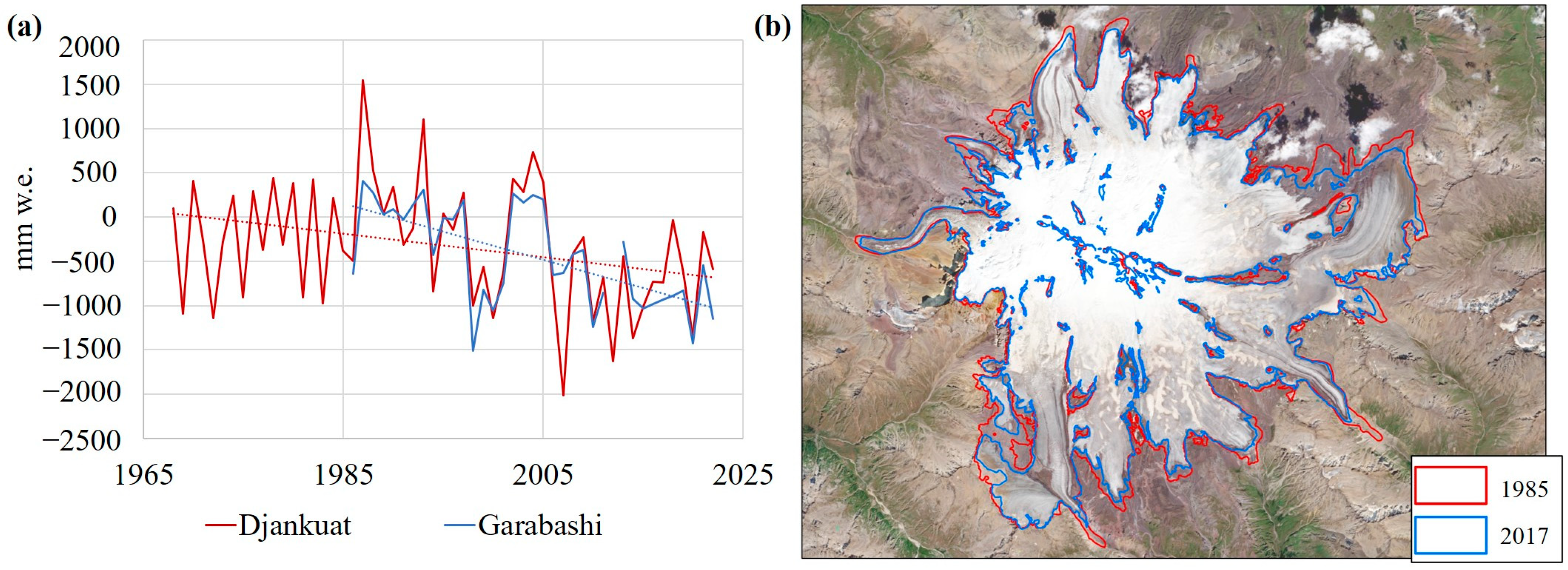
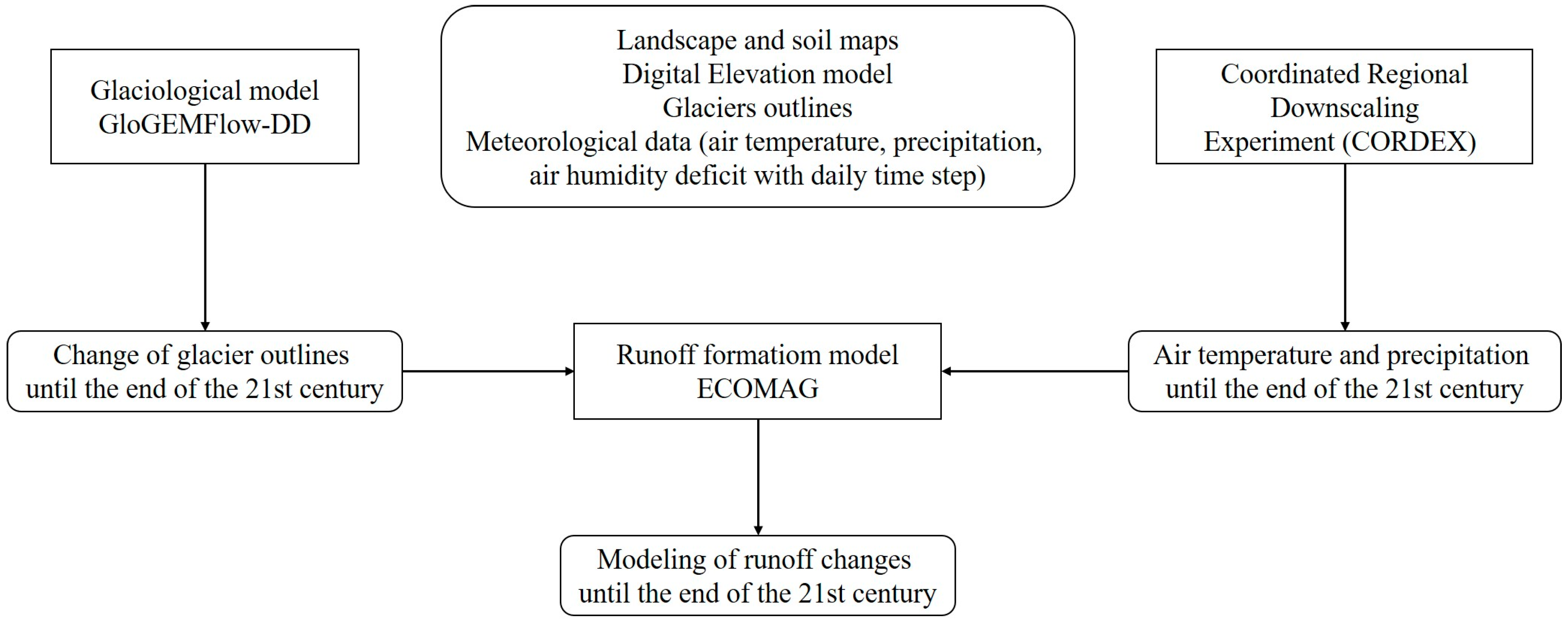


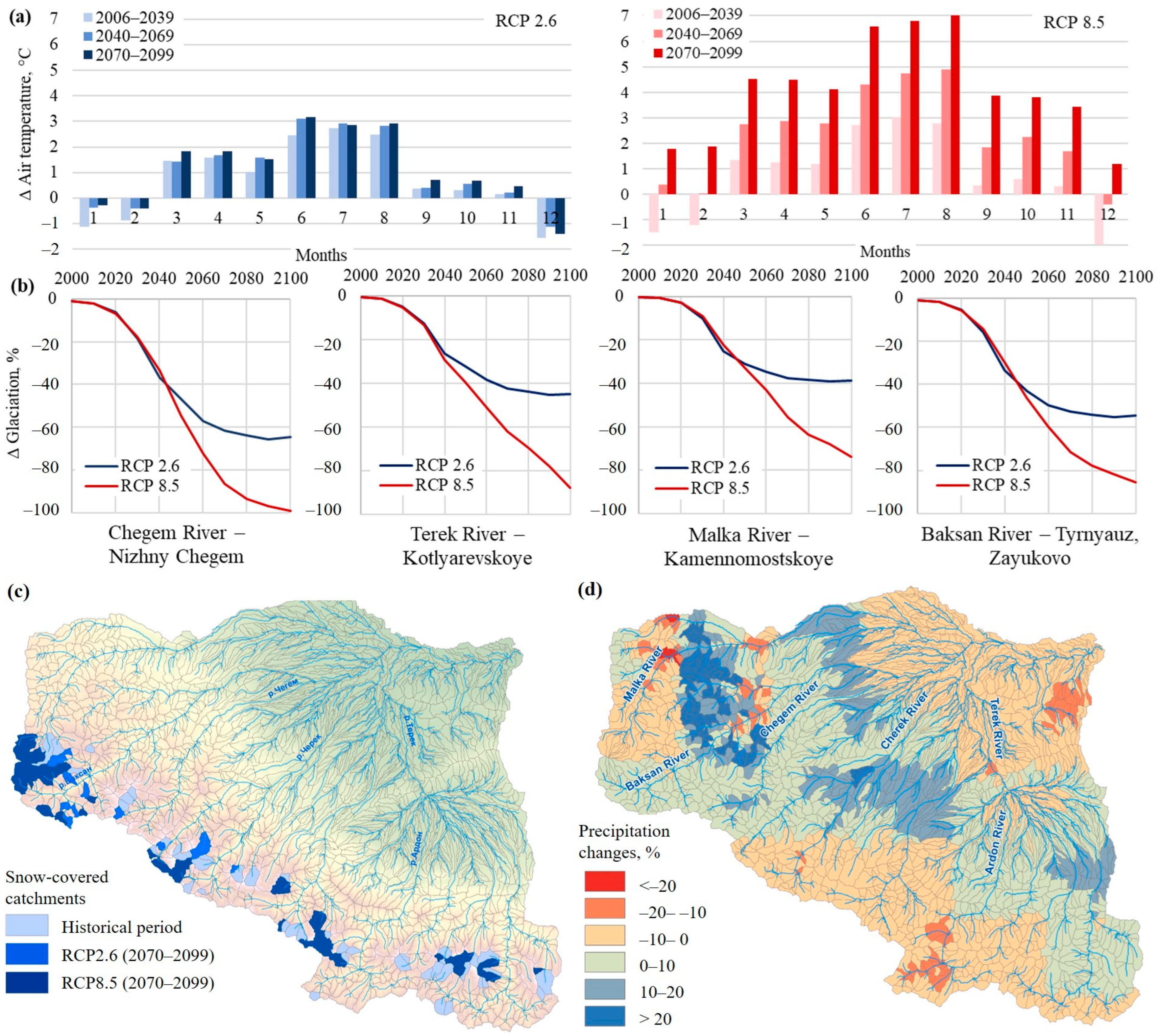
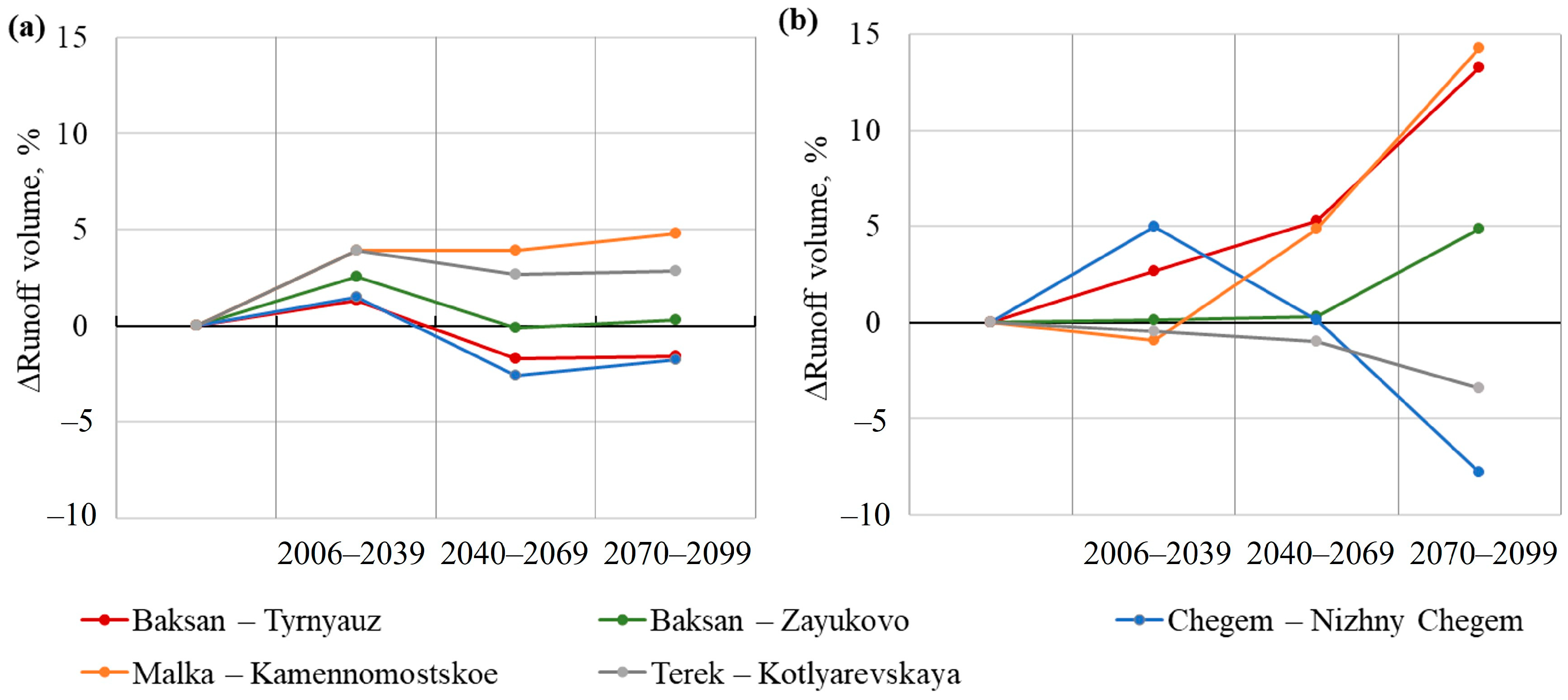
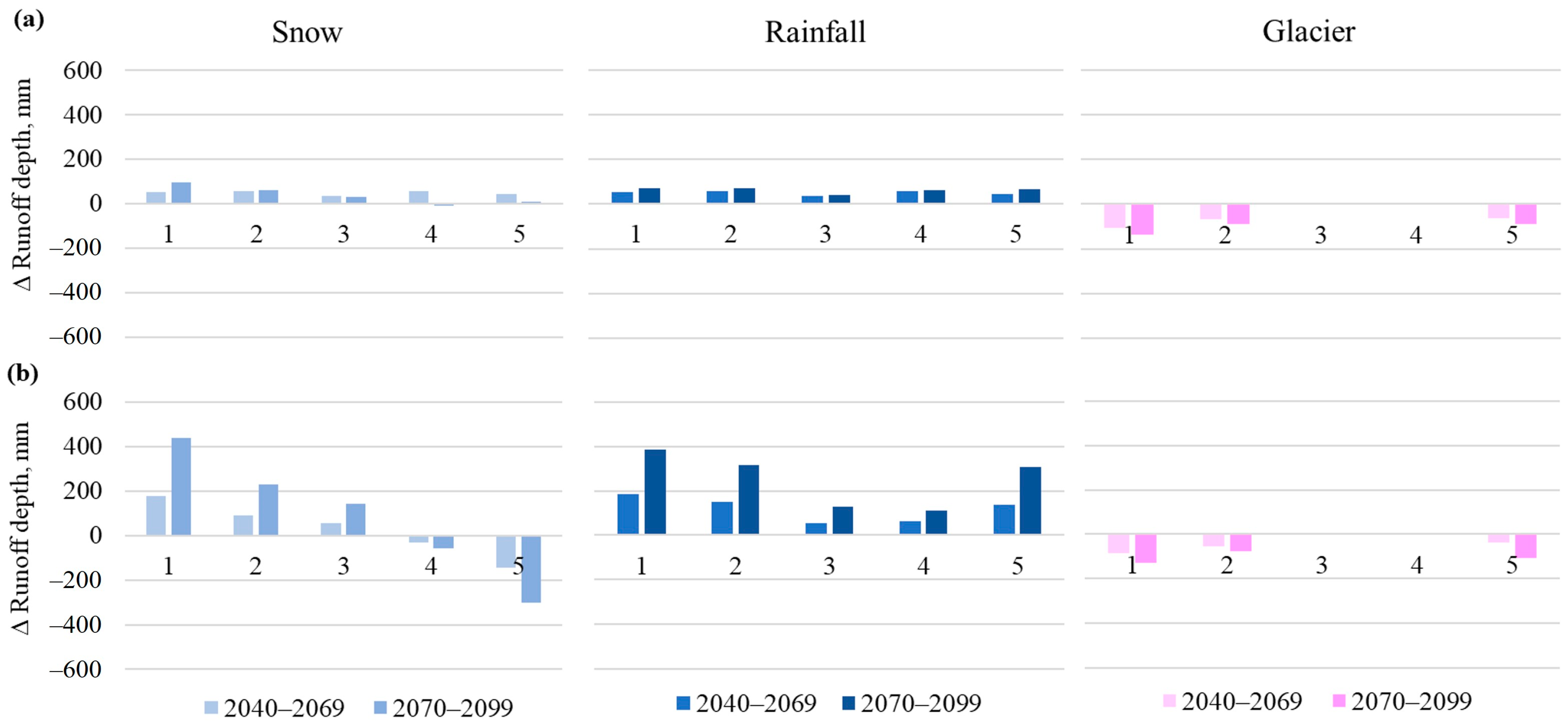

| Data Type | Period/Date of Publication of the Data | Spatial/Temporal Resolution | Source |
|---|---|---|---|
| Physical characteristics of the basin | |||
| Digital Elevation Model (SRTM) | 2000 | 90 m × 90 m | Consultative Group for International Agriculture Research Consortium for Spatial Information (CGIAR-CSI: http://srtm.csi.cgiar.org/ (accessed on 10 November 2023) |
| Land use | 1990 (Republic of North Ossetia), 1997 (Kabardino-Balkarian Republic) | 1:750,000 | Atlas of the Kabardino-Balkarian Republic and Republic of North Ossetia |
| Soil | 1990 (Republic of North Ossetia), 1997 (Kabardino-Balkarian Republic) | 1:750,000 | Atlas of the Kabardino-Balkarian Republic and Republic of North Ossetia |
| Glaciation area | 2001–2003 гг. | 10 m × 10 m | RGI 6.0 [44] |
| Hydrometeorological and glaciological data | |||
| River discharge | 1977–2018 (observed data) | Daily | Hydrology annual |
| Precipitation, temperature | 1977–2018 (observed data) | Daily | Meteorological base of the IWP RAS |
| 1977–2099 (historical and projected according RCP2.6 and RCP8.5) | Daily | CORDEX project [45] | |
| Glaciation area | 1990–2099 | 10 years | GloGEMflow-DD [46] |
| Gauging Station | Glaciation, % | Watershed Area, km2 | Calibration 2000–2008 | Validation 2009–2017 | ||||
|---|---|---|---|---|---|---|---|---|
| Day | Month | Year | Day | Month | Year | |||
| NSE | NSE | BIAS | NSE | NSE | BIAS | |||
| Baksan River—Tyrnyauz | 17.5 | 838 | 0.76 | 0.87 | −12.8 | 0.74 | 0.86 | −10.0 |
| Baksan River—Zayukovo | 7.4 | 2100 | 0.66 | 0.80 | 15.2 | 0.53 | 0.62 | 19.9 |
| Chegem River—Nizhny Chegem | 7.3 | 739 | 0.73 | 0.81 | −12.4 | 0.62 | 0.78 | −1.7 |
| Malka River—Kamennomostskoye | 3.4 | 1540 | 0.42 | 0.61 | 5.1 | 0.48 | 0.68 | 5.3 |
| Terek River—Kotlyarevskaya | 2.9 | 8920 | 0.56 | 0.72 | −7.0 | 0.45 | 0.68 | −9.4 |
| Parameter | Description | Range | Optimized Value |
|---|---|---|---|
| EKOPT | Factor for evaporation coefficient (dimensionless) | 0.4–0.7 | 0.7 |
| ALFOPT | Factor for melting factor, mm/day °C | 0.4–0.8 | 0.4 |
| Ulmax | Snow water-retaining capacity (dimensionless) | 0.1–0.7 | 0.1 |
| TCRst | Coefficient for the critical temperature of snow cover thawing (dimensionless) | −2–+2 | +2 |
| Rnew | Density of fresh snow, g/cm3 | 0.01–0.2 | 0.04 |
| GradT | Temperature gradient, °C/m | −0.005−0.007 | −0.0047 |
| GradP | Precipitation gradient, m/m | −0.0003–0.0007 | 0.00043 |
| Data | Values | Distribution | R2 | pBIAS, % |
|---|---|---|---|---|
| Snow data (MODIS) | Snow cover (%) | Daily | 0.72 | +19% |
| Monthly | 0.85 | +20% | ||
| Isotopic hydrograph separation | Meltwater runoff (m3/s) | Monthly | 0.81 | −18% |
| Rainfall runoff (m3/s) | Monthly | 0.86 | +20% | |
| Mass balance glacier observations (WGMS) | Garabashi ablation (mm) | Yearly | 0.20 | −15% |
| Djankuat ablation (mm) | Yearly | 0.18 | −55% |
Disclaimer/Publisher’s Note: The statements, opinions and data contained in all publications are solely those of the individual author(s) and contributor(s) and not of MDPI and/or the editor(s). MDPI and/or the editor(s) disclaim responsibility for any injury to people or property resulting from any ideas, methods, instructions or products referred to in the content. |
© 2025 by the authors. Licensee MDPI, Basel, Switzerland. This article is an open access article distributed under the terms and conditions of the Creative Commons Attribution (CC BY) license (https://creativecommons.org/licenses/by/4.0/).
Share and Cite
Pavlyukevich, E.D.; Krylenko, I.N.; Motovilov, Y.G.; Rets, E.P.; Korneva, I.A.; Postnikova, T.N.; Rybak, O.O. How Do Climate Change and Deglaciation Affect Runoff Formation Mechanisms in the High-Mountain River Basin of the North Caucasus? Glacies 2025, 2, 10. https://doi.org/10.3390/glacies2030010
Pavlyukevich ED, Krylenko IN, Motovilov YG, Rets EP, Korneva IA, Postnikova TN, Rybak OO. How Do Climate Change and Deglaciation Affect Runoff Formation Mechanisms in the High-Mountain River Basin of the North Caucasus? Glacies. 2025; 2(3):10. https://doi.org/10.3390/glacies2030010
Chicago/Turabian StylePavlyukevich, Ekaterina D., Inna N. Krylenko, Yuri G. Motovilov, Ekaterina P. Rets, Irina A. Korneva, Taisiya N. Postnikova, and Oleg O. Rybak. 2025. "How Do Climate Change and Deglaciation Affect Runoff Formation Mechanisms in the High-Mountain River Basin of the North Caucasus?" Glacies 2, no. 3: 10. https://doi.org/10.3390/glacies2030010
APA StylePavlyukevich, E. D., Krylenko, I. N., Motovilov, Y. G., Rets, E. P., Korneva, I. A., Postnikova, T. N., & Rybak, O. O. (2025). How Do Climate Change and Deglaciation Affect Runoff Formation Mechanisms in the High-Mountain River Basin of the North Caucasus? Glacies, 2(3), 10. https://doi.org/10.3390/glacies2030010







